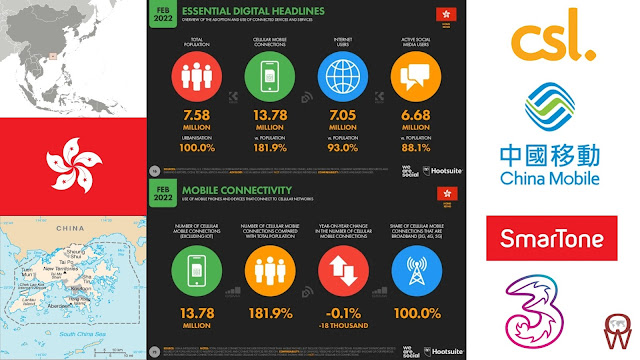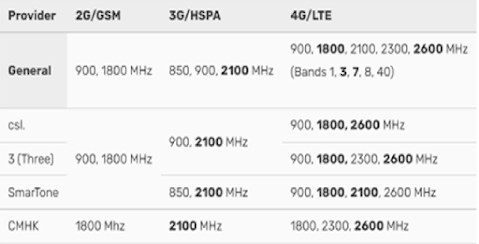Due to the combination of having a highly liberalised regulatory environment, very high-density housing spread across a small geographical area, and its strategic location at the southern tip of China, Hong Kong’s telecommunications sector continues to stay near the top of world rankings for the industry. It has kept its #1 spot in the Asian region in terms of the maturity of its telecom market – a reflection of the high penetration rates across mobile, mobile broadband, and fixed broadband. Even fixed-line teledensity in Hong Kong is impressive at over 50%, although it too has started a gradual decline in keeping with most other telecom markets around the world, as consumers slowly transition over to the mobile platform for all of their communication needs.
However, as China tightens its grip on the sovereignty of the territory and imposes political, commercial, and social restrictions that were absent during the British Colonial era, Hong Kong is starting to see its potency as a regional if not global force being eaten away by countries such as Singapore that now offer much greater freedom to operate.
Concerns over national security prompted the US Departments of Justice, Homeland Security, and Defense to prevent the branch line of the newly completed Pacific Light Cable Network (PLCN) linking Los Angeles with Taiwan from being lit. And ongoing issues with the deployment of Huawei technology inside the core infrastructure of telecom networks (something that has been done extensively in Hong Kong, including in its 5G networks) means that the territory – along with its telecom sector – may become increasingly isolated from the rest of the world. Consequently, Hong Kong is likely to drop back from its position as a regional and global leader in the telecom market.
Mobile networks in Hong Kong are independent from those in mainland China. Unlike there, in Hong Kong only GSM-operators are on the air if you buy a prepaid card there. Although HKT runs a CDMA network, there are few coverage spots and open for roaming only. The number has gone down to 4 in 2014 when CSL merged under the roof of Hong Kong Telecom: csl. (formerly CSL and PCCW Mobile, by Hong Kong Telecom), China Mobile Hong Kong (CMHK), Three (3, by Hutchison Whampoa) and SmarTone.
Main bands are marked in bold numbers. As many operators are refarming the 2G frequencies to 4G or 3G, only few resources remain for 2G. The major 3G frequency for all operators is on 2100 MHz and have very good coverage in the city. For 4G/LTE: the additional 2100 MHz band has been added firstly in MTR (metro) tunnels from 2016.
For the first time, Opensignal reported on both the 5G Experience and the overall mobile experience of all Hong Kong users its most recent report. Also two new award categories have been added that quantify the consistency of the mobile network experience.

Hong Kong Telecom merged the two smaller networks PCCW-HKT and one2free to the new provider called csl. after Telstra from Australia sold their shares in 2014. It has become the new market leader in Hong Kong on its combined network.
As the first mobile operator to launch a true 5G network with differentiated value-added services, csl identified a need to educate the market on how this new technology could change the way citizens perceived the world around them, and to show consumers how the technical attributes of 5G – such as low latency, high bandwidth and massive connectivity – were relevant to their everyday lifestyles.
A thematic TV commercial was created to demonstrate how 5G would change the way everyone perceives the world, and show it was about so much more than just speed. At the heart of the campaign was the notion 5G would improve people’s lives, and how it could transcend the limitations of space and time, while tearing down traditional human barriers such as age, physique and stamina.
China Mobile from mainland China is the biggest network provider of the world as far as the number of customers is concerned. It operates a network in Hong Kong too. Unlike in mainland China its 3G and 4G is fully compatible with GSM-devices from all over the world and data are not censored on Hong Kong SIM cards. Their 2G SIM cards have been discontinued, but may be still available and work as usual in the market.
The Ookla Q4 2021 report for Hong Kong found that China Mobile Hong Kong was the fastest mobile operator and had the fastest 5G download speed. See the full report for manufacturer information, device information, and more. https://t.co/P87G8tOnw0 pic.twitter.com/4Fadtf7JVB
— Speedtest by Ookla (@Speedtest) March 18, 2022
China Mobile Hong Kong (CMHK) has reached one million 5G mobile subscriptions, accounting for around one-fifth of its overall customer base. The firm launched Hong Kong’s first commercial 5G service in April 2020. Last month it won additional 5G-capable spectrum in the 700MHz, 2.6GHz and 4.9GHz bands, having previously been awarded frequencies in the 3.3GHz, 3.5GHz, 4.9GHz and 26GHz ranges in 2019.
Although SmarTone is the smallest operator in the city by market share, it constantly gets good reviews for its 3G and 4G service.
Hong Kong's SmarTone is shutting down 2G in October and will refarm the spectrum for 4G & 5G. No mention of 3G but it will be around for a while.https://t.co/1KAUP1m5GD#2G #3G #3G4G5G #2G3Gshutdown
— Zahid Ghadialy (@zahidtg) August 12, 2022
SmarTone has announced that it will close its GSM network on 14 October 2022, saying the move was ‘in response to the massive growth of mobile data usage in recent years and the decreasing market demand for 2G services’. According to the operator, as of April 2022 the number of customers using 2G handsets or devices accounted for less than 0.1% of its total mobile subscriptions. Confirming its plans, meanwhile, the operator noted that the 900MHz and 1800MHz spectrum resources currently deployed for its 2G infrastructure will be reallocated for use in its 4G and 5G networks.
To facilitate a smooth migration from 2G to more advanced mobile networks, SmarTone said it has been working with customers to upgrade 2G handsets or devices to those that support a higher generation mobile network since early 2021.
Three offers 2G, 3G, 4G/LTE mobile telecommunications and Wi-Fi services in Hong Kong. The MTR (metro, subway) is fully covered by LTE now.
3 Hong Kong has extended its 5G coverage at all station concourses, platforms and tunnels throughout the East Rail Line cross-harbour MTR link. Since 2019, 3 Hong Kong has invested more than HK$3 billion in mobile network expansion and 5G network development.
If HTHKH (i.e. 3 in Hong Kong) can launch 5G based FWA in *Hong Kong*, then nobody else should really be worried about if there's room for FWA in a mobile network? https://t.co/GLNQCDTgMd pic.twitter.com/j1PVYNSf0C
— tefficient 🚥 (@tefficient) February 28, 2022
With its effort and planning, the network team has been optimising its network covering newly-built transport infrastructure and public places. In addition to attaining 99% territory-wide 5G coverage at the end of 2020, 3 Hong Kong said it had become the first operator to build over 1000 golden spectrum band base stations in 2021, offering abundant network capacity. In the same year, 3 Hong Kong was ranked first in 5G availability in Hong Kong by an international organisation, indicating that customers are provided with the most reliable 5G experience.
Related Posts:
- Operator Watch Blog: 5G makes it debut in Hong Kong
- Operator Watch Blog: Hong Kong Getting Ready for 5G with Spectrum Auctions Conclusion
- The 3G4G Blog: 5G & AI Powered Smart Hospitals
- Telecoms Infrastructure Blog: Small Cells on Hong Kong Lamp Posts
- Telecoms Infrastructure Blog: Hong Kong gets LAA via SmarTone Small Cells



No comments:
Post a Comment